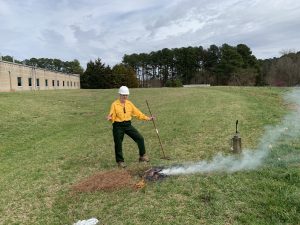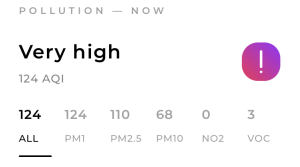Youth learn about resilience to wildfires, prescribed burns and air quality impacts
April 29, 2021
On Mar. 20, the UNC Institute for the Environment’s Center for Public Engagement with Science in collaboration with the North Carolina Museum of Natural Sciences (NCMNS) conducted a half-day virtual academy on the topic of climate change and forests for participants enrolled in the Youth Engaging in the Science of Resilience in Urban and Rural NC (YES-Resilience) Program.
In this virtual program, students explored the ecosystem services that forests provide, such as carbon storage and sequestration, before examining the impacts of climate change on our forest ecosystems, such as the increased risk of wildfire and resulting air quality impacts.
“Students were surprised to learn that North Carolina communities are among those at highest risk for wildfire in the country, due to the proximity of developed lands to wildlands, or the wildland-urban interface,” said Sarah Yelton, IE’s Environmental Education & Citizen Science Program Manager, and member of the YES-Resilience education team. “This discovery made learning about solutions that promote resilience, such as prescribed burns, even more meaningful.”
In 2019, the IE was awarded a $350,000 grant from the National Science Foundation’s Advancing Informal STEM Learning (AISL) program to develop and pilot the YES-Resilience Program. The program commenced in August 2020 and while the pandemic has prevented in-person programming from taking place, program staff have been diligent about creating interactive virtual sessions that are educational yet engaging.
“This half-day academy really exemplified the diverse strategies we are using to engage teenagers in an informal and virtual science education program,” says IE’s K-12 Science Education Manager, Dana Haine, co-PI and member of the YES-Resilience education team.
A range of STEM professionals from across the state contributed to the development and implementation of the program to showcase the relevance of wildfires and air quality concerns to our state. From environmental educators working with extension forestry to a biomedical researcher studying the impact of wildfire smoke on respiratory health, youth examined this topic from a number of perspectives, with many remarking that they had never really thought about the benefits of prescribed burns.
“Before attending this academy I didn’t know much about prescribed burns but now I know that they are actually very important for ecosystems,” remarked one participant at the conclusion of the event.

After learning about the air quality impacts of wildfires from Keith Bamberger, an air quality educator with the NC Division of Air Quality who made a live cameo appearance as the Air Avenger, youth learned how prescribed burns can help to prevent wildfires and help restore forest ecosystems such as the longleaf pine forests of North Carolina.
A highlight of the event was a live prescribed burn demonstration at the NCMNS Prairie Ridge Ecostation led by Erin Apple, NC Certified Environmental Educator, Coordinator of Youth Programs at the NCMNS and a part of the YES-Resilience Project Team. Erin is certified to conduct prescribed burns in NC and appreciated having the opportunity to educate youth about prescribed burns as a strategy to promote resilience to wildfire and protect human health.
“Generations of fire suppression have dramatically changed the landscape in our state, reducing critical, fire-dependent habitat for many of our most vulnerable wildlife species and putting human life and property at risk of catastrophic wildfire. Carefully controlled prescribed burns conducted under just the right conditions can prevent destructive and uncontrollable wildfires. I’m lucky enough to participate in conservation in action by working on prescribed burn crews in North Carolina, and by teaching young North Carolinians about the importance of fire,” says Apple.
 Apple wore a Flow personal air quality sensor during the prescribed burn and students examined air quality data before, during, and after the burn. This screenshot was taken during the burn event when smoke was at its peak.
Apple wore a Flow personal air quality sensor during the prescribed burn and students examined air quality data before, during, and after the burn. This screenshot was taken during the burn event when smoke was at its peak.Apple wore a Flow personal air quality sensor during the prescribed burn and students examined air quality data before, during, and after the burn. The YES-Resilience program is making these personal sensors available to participants interested in exploring air quality in their communities. After the live demonstration, participants learned how researchers are investigating the health effects of wildfire smoke from Ph.D. student Stephanie Brocke, a graduate student in the lab of Ilona Jaspers, Ph.D.
“This academy helped me understand how climate, human health, wildfires, and other climate issues are connected and how to deal with these issues better,” said another participant.
“The most exciting part of this program for me is that all of our participants, whether living in urban or rural North Carolina, were able to make a personal connection with the issues presented during our March Academy and think creatively about solutions that can make a difference for them, their families or their communities,” remarked Yelton.
Story by Dana Haine, K-12 Science Education Manager, Center for Public Engagement with Science.
